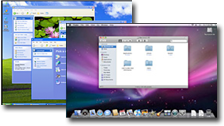Why switching to Mac was the right move for me

I'm now at the four month mark in my move to Mac. It didn't start out as a switch; when I bought my MacBook in the beginning of February I was really looking for an excuse to play with some new technology. I was satisfied—not excited mind you but satisfied—to use Windows as my operating system. I had my development environment on Windows and was well versed in all the ins and outs of it. I custom built my PCs myself, mildly over-clocking them to get better performance and being very comfortable in trouble shooting virtually any class of problem. I was a pretty hardcore Windows guy. What started as an addition to my little technology family evolved pretty rapidly though. Not only did I find the Mac intriguing and fun to use, I found myself enjoying my Windows machine that much less. The MacBook went from a curiosity to a cool toy to my preferred personal productivity tool in a very short period of time. After a couple of months I hadn't really switched though, my MacBook was...













